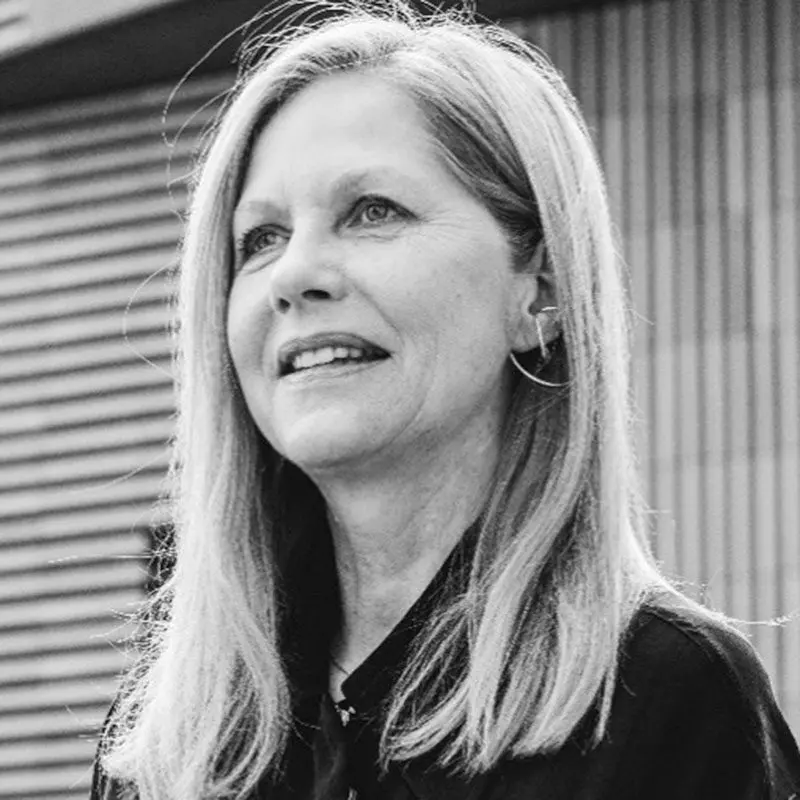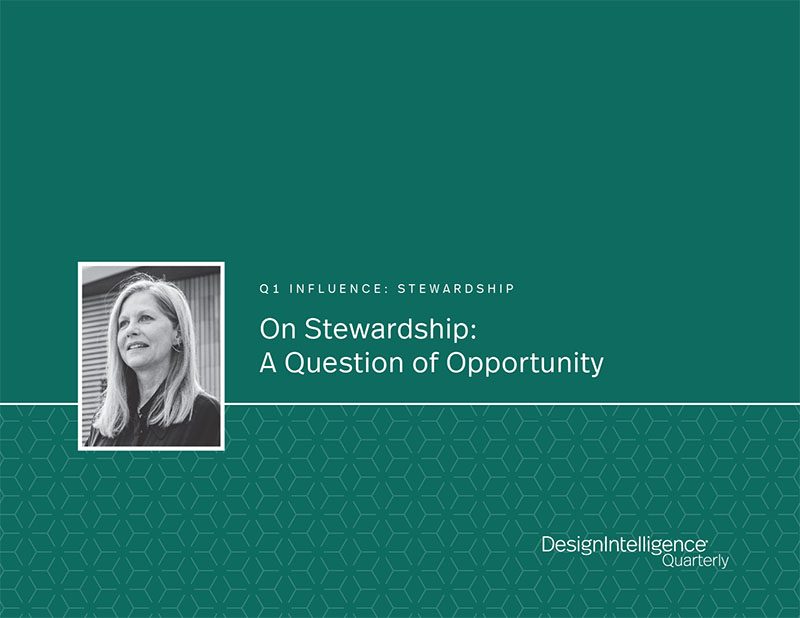On Stewardship: A Question of Opportunity
by Martha Thorne
Former Executive Director of the Pritzker Prize and IE Dean
February 9, 2022
Stewardship is one of those words with a rich definition. Its intrigue lies in the fact that it means different things to different people. Its origins stem from the notion of one who cared for a house, the ward or guardian who took care of a place or a home. Environmental stewardship carries broader connotations. Originally understood as “conservation” by the populace, the implicit meaning was the goal to protect nature. The creation of national parks in the USA can be seen as an example of this consciousness and actions based on the idea of the fragility of our natural environment and humans as the guardians to care for it.
In 1962, Rachel Carson’s seminal book “Silent Spring” suggested a shift to the concept of proactive stewardship — a mind shift required to stop the use of pesticides that would cause harm to our environment.
In the decades since the 1960s, the thinking around stewardship has been expanded to a global level in response to concerns about global warming and climate change. A 2015 Newsweek article showed us the emerging culture of stewardship through obvious examples such as wind farming in Denmark, geothermal energy in Iceland or executives bicycling to work.1 The “sharing economy” was to be an essential feature of stewardship according to this article, since “consumption is no longer a core value.” The author noted that the nemesis of stewardship is waste and went on to cite positive examples of architecture by Renzo Piano and Wang Shu. The former used sod to insulate a roof with geothermal energy solar panels. The latter recycled a million bricks and tiles in the Ningo Museum.
Each day we are deluged with more news of serious threats and devastating disasters occurring due to climate change. This pan-global increased attention extends from scientists and policymakers to the public, and, of course, architects who are intimately involved in the creation of our constructed environments.
Hand in glove with climate change concerns, the field of architecture is increasing attention to architecture’s social role of interpreting the word “social” in its broadest sense. In her 2011 DesignIntelligence Quarterly article, “The Social Responsibility of Architects,” Helena Jubany shared her opinion about architecture and social responsibility thus:
The social responsibility of architects lies in part in believing that architecture can create better places, that architecture can affect society and that it can even have a role in making a place civilized by making a community more livable.
This all sounds wonderful, but where’s the catch? Where are the friction points that impede our progress? The answers may lie in the very definition of the term architect. It seems that term — and our profession — are at a crossroads. In the days of old, most can agree that there was an accepted definition of what an architect was supposed to do. In his 1977 book, “The Architect: Chapters in the History of the Profession,” Spiro Kostof outlined a clear definition of architects that was used throughout much of the 20th century and is still in use in some circles:

Architects are conceivers of buildings. What they do is to design, that is supply concrete images for a new structure so that it can be put up. The primary task of an of the architect, then as now, is to communicate what proposed buildings should be and look like.2
In many circles, the emphasis then was on the outcome of the architectural process and the relationship with the client as the initiator of buildings. But in recent decades, the challenges to this antiquated definition began to become more frequent.
In her 2010 open letter to architects, Amy Choi´s scathing criticism ridicules architects and points out the irrelevance of the profession.3 To reinforce this line of thinking, designer Bruce Mau argues that architects “spent so much time policing the fence that you forgot to open the door.”
In other words, we have constructed such an exclusive professional fortress of accreditation, institutes, awards and even our own discourse, that we have lost touch with other people and adjacent disciplines — and what we could learn from them.
More recently, accreditation boards, schools and society in general are questioning the relevance of the traditional definition of the roles of those who design buildings. As evidence, we can witness the rise of architecture prizes for issues, sustainability, innovation, underrepresented parts of the profession, etc. that indirectly express disagreement with a narrow definition of the “design architect” (starchitect, if you will) as the best or only path to follow.
David Chipperfield provoked a response in his November 2020 DOMUS editorial.4 With his usual candor, he asked us:
What, then, is the role of the architect when the challenges of our time require us to tackle issues of a far larger scale, that require a more complex engagement of social representation, environmental consideration, and political mandate? Only in confronting these can we broach new levels of our professional potential.
The Question Remains
But the question remains, can and should architects move into social architecture, activism, climate change mitigation? Should they diverge from their traditional path, pushing the transformation of what is effectively a service industry into advocacy? And, if so, what are the paths to stewardship and how might they be cleared for others to follow?
Understanding the social (and perhaps even political nature) of architecture and adopting a model of stewardship is a matter of survival — for the profession and the planet. Never before in the history of our world have we been faced with such major challenges as rapid urbanization, the devastating effects of climate change, inequality, the need for decent housing, migration, the recent pandemic and its effects. Architecture deals with our built environment. By association, that means our natural and digital ones, as well.
A Profession at a Crossroads: Challenges Ahead
We are at a crossroads. Clearly, the old models of practice will not lead us all into a long-term future. Stewardship is caring for what we have and taking action for the future — with responsibility. This responsibility means understanding the impacts — direct and indirect, short- and long-term — of one´s actions. Who better to undertake this challenge than those trained in architecture? Architects are educated and encultured in both the understanding and creation of the built environment. We are skilled at dealing with complex matters and imagining scenarios for new futures and evaluating the potential of proposals from multiple perspectives.
An inflection point like the one we face compels us to enlarge the definition of the profession of architect. We must realize that we are dealing not only with architecture and design (or the creation of buildings and spaces), but that we are also operating within a broader context. This context includes our natural environment, policy and political components, and the economic framework. The design of our built environment is no longer just the resulting object, it is being able to respond to the questions of why and how. Answering those questions demands that we redefine and reevaluate the processes involved in making those constructions and that we work with many other disciplines to be able to ask and answer the questions responsibly.

Our second challenge has to do with the changing relationship we must learn to forge between the natural and constructed environments. It is time that we shift our approach. Moving from simply reducing consumption patterns, resource usage and recycling when easy and possible requires reinterpreting our relationship with resources in a completely new way. We cannot be content to think we can “handle” the problem of climate change by responding through our current policies and conventional actions. Such radical change requires a deeper understanding of our relationship with our world and a critical analysis of the cultural constructs of our actions — the things that have led us to the current predicament in the first place.
If
An opportunity stands before us …
If we can see ourselves as part of our environment instead of being managers of it …
If we can accept that there is no distinction between waste and supply, and that it is all part of our ecosystem and must be treated in a circular fashion …
If we can place our focus on processes as well as the product outcome …
then, maybe we have a chance.
Martha Thorne is dean of the IE School of Architecture and Design, part of the innovative IE University in Segovia/Madrid, Spain, educating students to face the important challenges of the 21st century as reflected in our built, natural and digital environments. In March 2021, she stepped down from the position of executive director of the Pritzker Architecture Prize, a role she held since 2005.
Throughout her career, she has observed architects and architecture seeking to communicate the importance of design, in the broadest sense, through exhibitions, writings and teaching through interests centering on two broad themes: the contemporary city and how architecture, design, and urbanism contribute to sustainability and resilience; and how architecture and design education can evolve in both content and pedagogy to be more relevant for today’s challenges. From 1995 to 2005, she worked as curator in Department of Architecture at the Art Institute of Chicago. She has written numerous articles for books and journals on contemporary architecture and the city.
She served on the Board of Directors of the International Archive of Women in Architecture and the Graham Foundation for Fine Arts. She has participated on many international juries, including the new National Museum of Chinese Art, Zaryadye Park in Moscow, and the international jury for ArcVision — Women and Architecture Prize. Thorne received a Master of City Planning degree from the University of Pennsylvania, a Bachelor of Arts degree in Urban Affairs from the State University of New York at Buffalo, and additional studies at the London School of Economics.
FOOTNOTES:
1. Barry Lord, “The ‘energy debate’ is really a revolution in what we think about everything,” Newsweek,
July 9, 2015. https://www.newsweek.com/energy-debate-really-revolution-what-we-think-about-everything-329965.
2. Spiro Kostof, The Architect: Chapters in the History of the Profession (New York: Oxford University Press, 1977), Preface, page XVIII
3. Annie Choi, “Dear Architects, I am sick of your shit,” Build LLC blog, September 3, 2010. https://blog.buildllc.com/2010/09/dear-architects-i-am-sick-of-your-shit-%E2%80%93-an-open-letter-by-annie-choi/.
4. David Chipperfield, “A che punto siamo ora? [editoriale] (Where do we stand now? [editorial]),” DOMUS 1051 (November 2020), 2–3.


